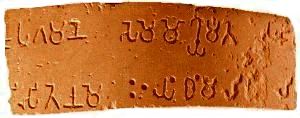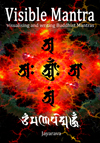On Visible Mantra several scripts are used for calligraphy. The main ones being siddhaṃ, Lantsa/Ranajana, and Tibetan (Uchen). These three are the most common scripts one is likely to encounter, although other scripts have been, and still are, used.
Brahmi
All Indian scripts, ultimately, derived from the Brahmi script (right) which came into widespread use during the time of King Aśoka. Buddhists initially resisted the use of writing, only resorting to writing down their texts some 4 or 5 centuries after writing was introduced to India. However once they started using writing, Buddhists became envangelists for it's use and spread the use of writing throughout South, and South East Asia as they spread the Buddhadharma.
Aśoka (6th) Pillar frgament
Brahmi inscription
formerly at Meerut. Mid-3rd century BCE.
(?u)pagamane sememokhyamate
(bhi)sitename iyaṃdhaṃmali(pi) li
© British Museum (my photo)
The example of Brahmi script shown is part of an incription by King Aśoka. The bottom line is part of a stock phrase which is found in other inscriptions:
[saḍuvīsativābhi]sitena me iyaṃ dhaṃma li[pi] li[khāpita]
"when I had been consecrated twenty-six years I ordered this inscription of the dhamma to be engraved".
- c.f. the 1st pillar in A. L. Basham The Wonder that was India, 1967, 2001, p.395.
A translation of what is left of pillar 6 is available at The Edicts of King Asoka : An English rendering by Ven. S. Dhammika.
The Indic script family tree shows how the various scripts descend from Brahmi. The Omniglot website has alphabets and examples of very many scripts.
Siddhaṃ 
Siddhaṃ is the main script used on Visible Mantra. Siddhaṃ was used in India during the period 6th - 12th centuries. It is preserved by the Shingon School of Japan where it is known as Bonji.
Siddhaṃ is also used in the Taisho edition of the Chinese Tripitaka to record mantras. The image below is from Taisho No.913 and reads oṃ a mṛ ta hūṃ pha ṭ - ie oṃ amṛta hūṃ phaṭ. Amṛta means "immortal" or "undying", and can also refer to a kind of elixir of life. Underneath is the Chinese transliteration, with information on pronunciation. T.913 is a Homa Pūja ritual manual.

Siddhaṃ is a descendent of the Gupta script and the name comes from the practice of teachers writing the word siddhaṃ at the top of a writing tablet for students to copy as a prelude to learning the rest of the script. Despite having a single name one finds a large variety of variations. It can be written with a pen or a brush. The focus on this site is pen style Siddhaṃ.
More information about Siddhaṃ on Visible Mantra
- The Ominglot Siddham page
- Modern Siddham page - brush style Siddham
Lantsa/Ranjana 
Although these two scritps are often conflated because they are quite similar there are subtle distinction in writing them. They are both Gupta derived scripts which emerged around the 1th century. The Tibetan variant is called Lantsa and it is mainly used for ceremonial purposes such as writing mantras or special Sanskrit phrases; The Nepalese Ranjana script is still in daily use to some extent - one can find newspapers with Ranjana headers for instance. Lantsa is written in several different styles. Some examples of this can be seen on the Ye Dharma/causation mantra page.
- The Ominglot Lantsa/Ranjana page
- Indian Scripts in Tibet - includes complete syllabaries including conjuncts for Lantsa and other Indian scripts in use Tibet as well as a number of distinctly Tibetan scripts. Also dotted around this website are mantras such as Vajrasattva in a variety of scripts. A very valuable resource!
Tibetan
In Tibet the Gupta script developed into a number of different scripts the main ones being Uchen (dbu-can) and Ume (dbu-me) of which you can find examples on Visible Mantra. There are also Drutsa ('bru-tsha) and Chuyik ('khyug-yig) and Bamyik ('bam-yig). The relationship of the Tibetan scripts to the vaireties of spoken Tibetan is complex, much like English.
For some high quality examples of Tibetan calligraphy see:
- Nathaniel Archer's Calligraphy photo's on Flickr. His works is of a very high standard of skill and originality.
- Tashi Mannox - beautiful calligraphy in a variety of scripts. Tashi trained in Tibetan art and writing as a Kagyu monk for 17 years.
Uchen (dbu-can) 
This script is what most people think of as "Tibetan". It is a formal script that has become the standard for printing. It is quite good for calligraphy though more demanding that Siddhaṃ
- The Ominglot Tibetan - Uchen page. Includes and example of gyuk yig script.
Ume (dbu-med) 
Ume (literally 'headless') is a cursive script for hand writing, which has general as well as sacred uses.
Other Scripts
 Amoung the other scripts on visiblemantra.org you will find some Kharoṣṭhī (read right to left) which is important as probably the earliest form of writing in India. The Arapacana alphabet which became associated with Mañjuśrī Mantra, originated as the alphabet of the Gāndhārī language written in Kharoṣṭhī. In recent years a number of caches of very old manuscripts written in the Kharoṣṭhī script have been found in the old Gāndhāra area. For more information on these texts see:
Amoung the other scripts on visiblemantra.org you will find some Kharoṣṭhī (read right to left) which is important as probably the earliest form of writing in India. The Arapacana alphabet which became associated with Mañjuśrī Mantra, originated as the alphabet of the Gāndhārī language written in Kharoṣṭhī. In recent years a number of caches of very old manuscripts written in the Kharoṣṭhī script have been found in the old Gāndhāra area. For more information on these texts see:
Where I have used Devanāgarī - देवनागरी - I have tended to rely on a font rather than doing calligraphy. A useful tool for this is: Transliterate Romanized to Sanskrit. Similarly for Japanese Kanji - 漢字 - I have used a font.
A script which is so far missing from here is Sinhalese. It is used for recording the Pāli texts and is therefore very important for Buddhism. It is derived from southern variants of Brahmi.
For a bit of fun I have added some made up scripts - Klingon and Elvish version of the Avalokiteśvara for instance.



